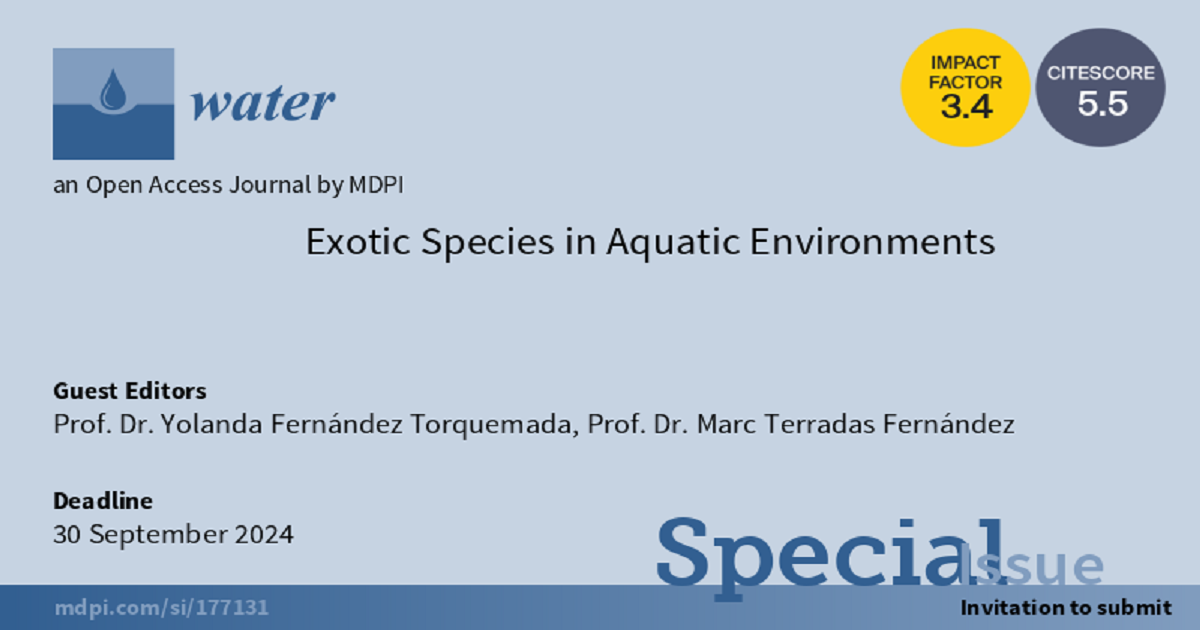Exotic Species in Aquatic Environments
A special issue of Water (ISSN 2073-4441). This special issue belongs to the section "Biodiversity and Functionality of Aquatic Ecosystems".
Deadline for manuscript submissions: closed (30 September 2024) | Viewed by 3902

Special Issue Editors
Interests: marine biology; coastal impacts; seagrasses; macrophytes; exotic species; bioindicators; mitigation impacts
Special Issues, Collections and Topics in MDPI journals
Special Issue Information
Dear Colleagues,
The introduction of exotic species into aquatic environments is a significant environmental issue with far-reaching consequences. Exotic species, also known as alien or non-indigenous species (NIS), refer to organisms that have been introduced to regions outside their natural range due to human activities. This introduction can occur through various pathways, including the discharge of ballast water from ships, aquaculture practices, the aquarium trade, accidental releases, and intentional species introductions for recreational purposes. Once established, these species have the potential to rapidly spread and become invasive, leading to competition with native species and causing economic and ecological harm. The proliferation of exotic species in aquatic environments poses a threat to biodiversity, ecosystem function, and human activities, such as fisheries and water resource management.
This Special Issue aims to gather current research on the introduction and dispersal of new exotic species in aquatic environments. We are particularly interested in studies focusing on the potential ecological and economic impacts of non-indigenous species (NIS). Research encompassing monitoring and management strategies, including control and eradication measures, as well as the restoration of impacted ecosystems to their original states, are also highly encouraged.
Prof. Dr. Yolanda Fernández Torquemada
Prof. Dr. Marc Terradas Fernández
Guest Editors
Manuscript Submission Information
Manuscripts should be submitted online at www.mdpi.com by registering and logging in to this website. Once you are registered, click here to go to the submission form. Manuscripts can be submitted until the deadline. All submissions that pass pre-check are peer-reviewed. Accepted papers will be published continuously in the journal (as soon as accepted) and will be listed together on the special issue website. Research articles, review articles as well as short communications are invited. For planned papers, a title and short abstract (about 100 words) can be sent to the Editorial Office for announcement on this website.
Submitted manuscripts should not have been published previously, nor be under consideration for publication elsewhere (except conference proceedings papers). All manuscripts are thoroughly refereed through a single-blind peer-review process. A guide for authors and other relevant information for submission of manuscripts is available on the Instructions for Authors page. Water is an international peer-reviewed open access semimonthly journal published by MDPI.
Please visit the Instructions for Authors page before submitting a manuscript. The Article Processing Charge (APC) for publication in this open access journal is 2600 CHF (Swiss Francs). Submitted papers should be well formatted and use good English. Authors may use MDPI's English editing service prior to publication or during author revisions.
Keywords
- exotic, alien, or non-indigenous species (NIS)
- invasive species
- ecological impacts
- biodiversity
- introduction pathways
- invasion mechanisms
- prevention and control
- management strategies
Benefits of Publishing in a Special Issue
- Ease of navigation: Grouping papers by topic helps scholars navigate broad scope journals more efficiently.
- Greater discoverability: Special Issues support the reach and impact of scientific research. Articles in Special Issues are more discoverable and cited more frequently.
- Expansion of research network: Special Issues facilitate connections among authors, fostering scientific collaborations.
- External promotion: Articles in Special Issues are often promoted through the journal's social media, increasing their visibility.
- e-Book format: Special Issues with more than 10 articles can be published as dedicated e-books, ensuring wide and rapid dissemination.
Further information on MDPI's Special Issue polices can be found here.






